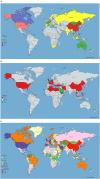Unraveling the Epidemiology, Geographical Distribution, and Genomic Evolution of Potentially Lethal Coronaviruses (SARS, MERS, and SARS CoV-2)
- PMID: 32974224
- PMCID: PMC7481402
- DOI: 10.3389/fcimb.2020.00499
Unraveling the Epidemiology, Geographical Distribution, and Genomic Evolution of Potentially Lethal Coronaviruses (SARS, MERS, and SARS CoV-2)
Abstract
SARS CoV appeared in 2003 in China, transmitted from bats to humans via eating infected animals. It affected 8,096 humans with a death rate of 11% affecting 21 countries. The receptor binding domain (RBD) in S protein of this virus gets attached with the ACE2 receptors present on human cells. MERS CoV was first reported in 2012 in Middle East, originated from bat and transmitted to humans through camels. MERS CoV has a fatality rate of 35% and last case reported was in 2017 making a total of 1,879 cases worldwide. DPP4 expressed on human cells is the main attaching site for RBD in S protein of MERS CoV. Folding of RBD plays a crucial role in its pathogenesis. Virus causing COVID-19 was named as SARS CoV-2 due its homology with SARS CoV that emerged in 2003. It has become a pandemic affecting nearly 200 countries in just 3 months' time with a death rate of 2-3% currently. The new virus is fast spreading, but it utilizes the same RBD and ACE2 receptors along with furin present in human cells. The lessons learned from the SARS and MERS epidemics are the best social weapons to face and fight against this novel global threat.
Keywords: ACE2; COVID-19; DPP4; MERS CoV; SARS CoV; SARS CoV-2.
Copyright © 2020 Masood, Malik, Raja, Mubarik and Yu.
Figures


Similar articles
-
[Source of the COVID-19 pandemic: ecology and genetics of coronaviruses (Betacoronavirus: Coronaviridae) SARS-CoV, SARS-CoV-2 (subgenus Sarbecovirus), and MERS-CoV (subgenus Merbecovirus).].Vopr Virusol. 2020;65(2):62-70. doi: 10.36233/0507-4088-2020-65-2-62-70. Vopr Virusol. 2020. PMID: 32515561 Review. Russian.
-
Composition and divergence of coronavirus spike proteins and host ACE2 receptors predict potential intermediate hosts of SARS-CoV-2.J Med Virol. 2020 Jun;92(6):595-601. doi: 10.1002/jmv.25726. Epub 2020 Mar 11. J Med Virol. 2020. PMID: 32100877 Free PMC article.
-
Molecular Basis of Pathogenesis of Coronaviruses: A Comparative Genomics Approach to Planetary Health to Prevent Zoonotic Outbreaks in the 21st Century.OMICS. 2020 Nov;24(11):634-644. doi: 10.1089/omi.2020.0131. Epub 2020 Sep 16. OMICS. 2020. PMID: 32940573 Review.
-
Structural basis of receptor recognition by SARS-CoV-2.Nature. 2020 May;581(7807):221-224. doi: 10.1038/s41586-020-2179-y. Epub 2020 Mar 30. Nature. 2020. PMID: 32225175 Free PMC article.
-
Role of the GTNGTKR motif in the N-terminal receptor-binding domain of the SARS-CoV-2 spike protein.Virus Res. 2020 Sep;286:198058. doi: 10.1016/j.virusres.2020.198058. Epub 2020 Jun 9. Virus Res. 2020. PMID: 32531235 Free PMC article.
Cited by
-
Molecular modeling of some commercially available antiviral drugs and their derivatives against SARS-CoV-2 infection.Narra J. 2024 Apr;4(1):e319. doi: 10.52225/narra.v4i1.319. Epub 2024 Apr 30. Narra J. 2024. PMID: 38798846 Free PMC article.
-
Emerging Variants of Canine Enteric Coronavirus Associated with Outbreaks of Gastroenteric Disease.Emerg Infect Dis. 2024 Jun;30(6):1240-1244. doi: 10.3201/eid3006.231184. Emerg Infect Dis. 2024. PMID: 38782018 Free PMC article.
-
An in silico approach to develop potential therapies against Middle East Respiratory Syndrome Coronavirus (MERS-CoV).Heliyon. 2024 Feb 9;10(4):e25837. doi: 10.1016/j.heliyon.2024.e25837. eCollection 2024 Feb 29. Heliyon. 2024. PMID: 38379969 Free PMC article.
-
Emerging and re-emerging zoonotic viral diseases in Southeast Asia: One Health challenge.Front Public Health. 2023 Jun 13;11:1141483. doi: 10.3389/fpubh.2023.1141483. eCollection 2023. Front Public Health. 2023. PMID: 37383270 Free PMC article. Review.
-
Single Nucleotide Variants (SNVs) of Angiotensin-Converting Enzymes (ACE1 and ACE2): A Plausible Explanation for the Global Variation in COVID-19 Prevalence.J Renin Angiotensin Aldosterone Syst. 2023 Apr 3;2023:9668008. doi: 10.1155/2023/9668008. eCollection 2023. J Renin Angiotensin Aldosterone Syst. 2023. PMID: 37051471 Free PMC article. Review.
References
Publication types
MeSH terms
Substances
LinkOut - more resources
Full Text Sources
Miscellaneous

